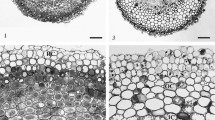Summary
The losses of marked metabolites of 14C-glucose in Pisum roots were determined by means of liquid scintillation counting during different electron microscopic preparation schedules. 14C-glucose was applied to the roots. Metabolites were identified in thinlayer chromatographs and radioautographs. Fixation with glutaraldehyde (glut.) followed by OsO4 rendered the radioactivity in the tissue less susceptible to ethanolic extraction than treatment with either glut. or OsO4. The ethanolic extracts showed 76 per cent of their radioactivity in glucose, the remainder in amino acids and nitrogen-free acids. Continuous dehydration by acetone instead of stepwise dehydration by acetone, ethanol, and propylene oxide further reduces extraction. Even better results are achieved by adding sucrose to the fixation and dehydration media. Finally, after fixation with OsO4 fumes followed by continuous dehydration, most of the incorporated radioactivity is retained in the tissue. The passage through high acetone and ethanol concentrations as well as through propylene oxide and epon does not cause significant losses. Glut. and acroleine do not differ significantly with respect to the retention of radioactivity. In all preparations the larger part of the retained radioactivity is found in glucose. It is suggested that glucose is predominantly retained because of membrane changes during fixation, whereas the amino acid retention is enhanced by reactions with the fixing agents.
Zusammenfassung
Die Verluste an radioaktiv markierten, aus d-Glucose-14C in Pisum-Wurzeln entstandenen Substanzen, die im Verlauf unterschiedlicher Präparationsmethoden für die Elektronenmikroskopie auftreten, werden mit einem Flüssigszintillationszähler bestimmt. Die Identifizierung der Metabolite erfolgt an Hand von Dünnschichtchromatogrammen und Autoradiographien. Nach Flüssigfixierung mit Glutaraldehyd (Glut.) und OsO4 wird weniger äthanollösliche Radioaktivität, die zu ca. 76% in Glucose, sonst aber in Aminosäuren und N-freien Säuren vorliegt, extrahiert, als nach Einzelfixierung mit einem der genannten Fixierungsmittel.
Durch stufenlose Acetonentwässerung, anstelle von Entwässerung in Aceton-bzw. Äthanol-Stufen und Propylenoxyd, ferner durch Zusetzen von Saccharose zu den Fixierungs- und Entwässerungs-Medien, kann die Extraktion weiter reduziert werden. Nach OsO4-Räucherung und stufenloser Entwässerung bleibt die größte Menge an Radioaktivität im Gewebe. Der Aufenthalt in den hohen Aceton- und Äthanolstufen bringt hier keine hohen Verluste mit sich, dasselbe gilt für Propylenoxyd und Epon. Glut. und Acrolein unterscheiden sich hinsichtlich der Retention an Radioaktivität nicht wesentlich.
In allen Präparationen besteht der größte Teil der verbleibenden Radioaktivität aus Glucose. Es wird vermutet, daß diese hauptsächlich auf Grund von Membranveränderungen zurückbleibt, die Aminosäuren zusätzlich durch ihre Reaktion mit den Fixantien.
Similar content being viewed by others
Literatur
Ashworth, C.T., Leonard, J.S., Eigenbrodt, E.H., Wrightsman, F.J.: Hepatic intracellular osmiophilic droplets. Effect of lipid solvents during tissue preparation. J. Cell Biol. 31, 301–318 (1966)
Buschmann, R.J., Taylor, A.B.: The effect of 0° C and 2,4-DNP on the uptake of micellar fatty acids, on the extraction of absorbed lipid during electron microscopy processing, and on the ultrastructure of everted jejunum. J. Ultrastruct. Res. 35, 98–111 (1971)
Cope, G., Williams, H.A.: Quantitative studies on neutral lipid preservation in electron microscopy. J. Roy. Microsc. Soc. 88, 259–277 (1968)
Dallam, R.D.: Determination of protein and lipid lost during osmic acid fixation of tissues and cellular particulates. J. Histochem. Cytochem. 5, 178–181 (1957)
Fritz, E., Eschrich, W.: 14C-Mikroautoradiographie wasserlöslicher Substanzen im Phloem. Planta (Berl.) 92, 267–281 (1970)
Frühling, J., Penasse, W., Sand, G., Claude, A.: Preservation du cholesterol dans le corticosurrénale du rat au course de la préparation des tissus pour la microscopie électronique. J. Microscopie 8, 957–982 (1969)
Geyer, G.: Lipid fixation. Acta histochem. (Jena), Suppl. 19, 209–222 (1977)
Halbhuber, K.J.: Voraussetzungen und Bedingungenfür den Einsatz von radioaktiv markierten Verbindungen zur Optimierung histochemischer Untersuchungsverfahren. Acta histochem. (Jena), Suppl. 15, 277–290 (1975)
Heinrich, G.: Über den Glucose-Metabolismus in Nektarien zweier Aloe-Arten und über den Mechanismus der Pronektar-Sekretion. Protoplasma 85, 351–371 (1975)
Heinrich, G., Dános, B.: Substanzverluste aus Gasteria-Fruchtknoten nach Angebot von 14C-Glucose im Verlauf gebräuchlicher Präparationsmethoden für die Elektronenmikroskopie. Biochem. Physiol. Pflanzen 172, 515–525 (1978)
Heyser, W., Leonard, O., Heyser, R., Fritz, E., Eschrich, W.: The influence of light, darkness, and lack of CO2 on phloem transport in detached maize leaves. Planta (Berl.) 122, 143–154 (1975)
Korn, E.D. and Weisman, R.A.: Loss of lipids during preparation of amoebae for electron microscopy. Biochem. Biophys. Acta. 116, 309–316 (1966)
Linß, W.: Lipiderhaltende Einbettungsverfahren in der Elektronenmikroskopie. Acta histochem. (Jena), Suppl. 19, 229–238 (1977)
Lüttge, U., Weigel, J.: Mikroautoradiographische Untersuchungen der Aufnahme und des Transportes von 35 −−4 und 45Ca++ in Keimwurzeln von Zea mays und Pisum sativum L. Planta 58, 113–126 (1962)
Monneron, A., Moulé, Y.: Critical evaluation of specificity in electron microscopical radioautography in animal tissues. Exp. Cell Res. 56, 179–193 (1969)
Morgan, T.E., Huber, G.L.: Loss of lipid during fixation for electron microscopy. J. Cell Biol. 32, 757–760 (1967)
Peters, T.H., Ashley, C.H.A.: An artefact in radioautography due to binding of free amino acids to tissue by fixatives. J. Cell Biol. 33, 53–60 (1967)
Sitte, P.: Einfaches Verfahren zur stufenlosen Gewebe-Entwässerung für die elektronenmikroskopische Präparation. Naturwissenschaften 49, 402–403 (1962)
Tixier-Vidal, A., Picart, R.: Étude quantitative par radioautographie au microscope électronique de l'utilisation de la DL-Leucin-3H par les cellules de l'hypophyse du canard en culture organotypique. J. Cell Biol. 35, 501–519 (1967)
Vanha-Perttula, T., Grimley, P.M.: Loss of proteins and other macromolecules during preparation of cell cultures for high resolution autoradiography. J. Histochem. Cytochem. 18, 565–573 (1970)
Author information
Authors and Affiliations
Rights and permissions
About this article
Cite this article
Heinrich, G., Kuschki, B. Verluste radioaktiv markierter Substanzen aus Pisum-Wurzeln nach Verfütterung von D-Glucose-14C im Verlauf unterschiedlicher Präparationsmethoden für die Elektronenmikroskopie. Histochemistry 58, 319–328 (1978). https://doi.org/10.1007/BF00495388
Received:
Issue Date:
DOI: https://doi.org/10.1007/BF00495388




